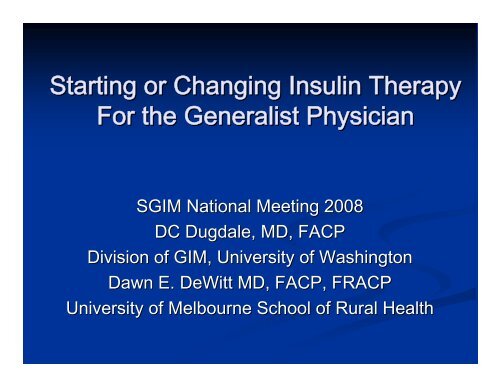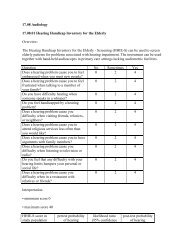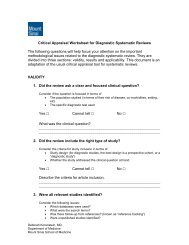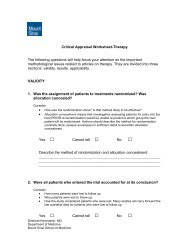Handout - SGIM
Handout - SGIM
Handout - SGIM
Create successful ePaper yourself
Turn your PDF publications into a flip-book with our unique Google optimized e-Paper software.
Starting or Changing Insulin TherapyFor the Generalist Physician<strong>SGIM</strong> National Meeting 2008DC Dugdale, MD, FACPDivision of GIM, University of WashingtonDawn E. DeWitt MD, FACP, FRACPUniversity of Melbourne School of Rural Health
Disclosures:Dr. Dugdale - NoneDr. DeWitt - Sanofi Aventis Advisory Board(Australia)AcknowledgementsIrl Hirsch, MDAlex Dugdale
Learning Goals• Understand the use of new insulins including rapidacting and long acting insulins (e.g., lispro, aspart,glulisine, glargine and detemir) in outpatients.• Know how to select appropriate patients for andtransition them to using the new insulins.• Know how to use older insulins in patients whoseneeds are well-served by these drugs or for whomformulary restrictions require their use.• Review indications for new injectable agents such asexenatide and pramlintide.• Develop strategies for teaching outpatient insulintherapy to trainees
Prioritizing Treatments: T2DM•Blood Blood pressure:
Diabetes Toolbox 2008You should be able to control virtually all patientssafely with these tools to A1C ~7%1. Glucometer and A1c (HbA1c)2. Metformin (1000 mg bid)3. Insulin glargine (basal)- ~ 0.5-1 1 unit/kg4. Insulin aspart (rapid) ~ 0.5-1 1 unit/kg5. Aspart pre-mix (70/30)6. Sulfonylurea (SU)7. Frequent insulin adjustment by patient1.2.3.4.5.6.7.
Initiating Insulin: Type 2 DM• What is the mean level of HbA1c at whichinsulin is started in the US:• A: 8%• B: 9%• C: 10%• D: 11%
Initiating Insulin: Type 2 DM• CORRECT ANSWER IS:• C: 10% (10.4%, JAMA 1997)
Goals of Glycemic Treatment: ADA•Perform Perform the A1C test• at least two times a year in patients who are meetingtreatment goals and who have stable glycemic control(Grade E)•quarterly in patients whose therapy has changed orwho are not meeting glycemic goals (Grade E)•The The A1C goal• for patients in general:
The limits of A1c: ACCORDWilliam T. Friedewald, MD, ACCORD Steering Committee Chair• Action to Control Cardiovascular Risk in Diabetes• > 10,000 patients T2DM + two other CVD risk factors• Goals: Intensive (A1C < 6%) or standard (A1C 7% -7.9%)• Half of the participants in the intensive treatment groupachieved an A1C < 6.4%• Half of the “standard” participants achieved an A1C
Diabetes Toolbox2008Alternatives to Insulinswhen metformin + SUdoes not reach goals
Alternatives to Insulin• Acarbose• TZDs• Incretins• NONE have the proven track record ofinsulin vis-à-vis safety and efficacy(including reduction of complications)
Incretins• Gut-derived factors that increase glucosestimulatedinsulin secretion• In•Cre•Tin• Intestine Secretion Insulin• Diabetologia 1985:28:5645
Incretin Overview• Incretins have many actions, includingincreasing glucose-stimulated stimulated insulinsecretion after oral intake• Amylin and GLP-1 1 are incretins• Amylin secretion is reduced in T1DM• GLP-1 1 secretion is reduced in T2DM• GLP-1 1 inactivated by DPP-4 4 (dipeptidylpeptidase-4)• Inhibition of DPP-4 4 increases GLP-1 1 effect
Incretin-Related agents to treatDiabetes• Exenatide (Byetta)• Pramlintide (Symlin)• Sitagliptin (Januvia)• NONE have long term records for safetyor efficacy that are comparable tometformin, SUs, and insulin
Exenatide• A GLP-1 1 receptor agonist: increases glucose stimulated insulinsecretion; modulates gastric emptying• FDA approval: T2DM in pts taking 1 or 2 of MET, SU, TZD• Given 5 or 10 mcg SC BID• Will not cause hypoglycemia unless given with other drug that causeshypoglycemia• RCT of T2DM patients with mean FBG 185, A1c 8.2%, (range 7-710%), BMI 25-45, on max MET + SU x 26 weeks• Exenatide 5 mcg BID (AC) for 4 weeks, then 10 mcg BID (AC) vs.glargine, started at 10 units q day and increased to achieve FBG
Exenatide, cont’d• Mean final glargine dose 25 units qday• A1c ↓ 1.1% in both groups; 46% or 48% achieved A1c
Pramlintide• Amylinomimetic: modulates gastric emptying• FDA approval:• T1DM, adjunct to insulin• T2DM, adjunct to insulin• Dosing• T1DM: 15-60 mcg SC immediately prior to major meal• T2DM: 60-120 mcg SC immediately prior to major meal• Risk of hypoglycemia significant when used according to FDAindications• Not recommended
Sitagliptin• DPP-4 4 inhibitor: increases GLP-1• FDA approval: T2DM monotherapy or combination therapy• Dosing: 100 mg PO in AM; may need to lower SU dose• Will not cause hypoglycemia unless given with other drug that causeshypoglycemia• Monotherapy• A1c reduction ~0.5% if baseline 9%• Fasting BG reduced by 13 mg/dL; 2 hr PP BG reduced by 49 mg/dL• Combination therapy: 24 week RCT of pts with A1c 7.5%-11%• A1c reductions• MET 500 BID: 0.82%• MET 500 BID + sitagliptin 50 BID: 1.4%• MET 1000 BID: 1.13%• MET 1000 BID + sitagliptin 50 BID: 1.9%• DPP-4 4 ubiquitous in body, so effects on other organ systems possible
Diabetes Toolbox2008Helping trainees learn how toprovide good diabetes careand use insulin therapy
Strategies for trainees• Understand concept of “clinical inertia”, , and howit can retard achieving treatment goals• Understand limitations of HBA1c as a test• Familiarity with BG meter and home BG testing• Understand injection technique• Algorithmic approach to insulin for outpatients,esp. “Treat to Target”• The strategies used for inpatients are not appropriatefor most outpatients with T2DM
Factors that alter HBA1c• Altered RBC turnover changes HBA1c-BG BG correlation• Affects up to 15% of patients, even after excluding thosewith known anemia or kidney disease• Shorter RBC life span lowers A1C• Hemolysis• Hemoglobinopathy• Liver disease• Kidney disease (e.g., serum creatinine > 2 mg/dL)• Pregnancy• Lowers HBA1c by inhibiting glycation: Vitamins C andE• Raises HBA1c• Hypoproliferative anemia• National Glycohemoglobin Standardization Program web site; JAMA2006;295:1688-1696.1696.
HBA1c interpretation• 6% ~ mean BG 135 mg/dL• 1% rise ~ 35 mg/dL rise in mean BG• HOWEVER these data come from “77 point”BG data collected in the DCCT, and are not asprecise as one might think----Revision likely in2008• Total imprecision ~4% of reading (at least)• 7% = 6.72% - 7.28%• 8% = 7.68% - 8.32%• Multiple assays with HPLC and “rapid”methods being most common
Blood Glucose Meters• Desirable features:• Rapid processing (5 seconds)• Small sample size• Memory• Averages• Pre- and post-prandial prandial flagging• Logbook function• Most meters have free software that allowanalysis• Standard deviation can assess glycemic variability• Most physician offices DO NOT have thiscapability (>90%)
Blood Glucose Meters• One Touch Ultra• Not the One Touch Mini• Freestyle Flash• For Medicaid patients• Payment for meters is fixed, so pharmacies typicallydispense cheaper meter (WA state----True Track)• Payment for strips is not fixed, so patient with moreexpensive meter can get strips
Diabetes Toolbox2008Insulins
Case 1• A 53 year old man presents with polyuriaand fatigue for 3 months.• PMH: MI with CHF and HTN• BG = 478, HBA1c 9.9%.• Random BG 4 months previously was 133
Case 1• How would you treat this patient?A. GlyburideB. Glyburide and metforminC. Metformin and bedtime glargineD. Glyburide and bedtime glargineE. Basal-prandial insulin
Initiating Insulin in T2DM• Metformin and bedtime glargine (NPH alsoreasonable)• Basal-prandial; Acceptable but probably overlycomplex• Glyburide or Glyburide + metformin: HBA1c toohigh for this to be likely to work well• Metformin has been contraindicated in CHF butstable CHF is no longer a contraindication tometformin
Case 1 Management•Initial Initial Rx: glyburide 5 mg qAM, and NPHinsulin 10 units.•Increase by 2 units every 3 days if fasting BG >120•Over Over 2 months, fasting BGs went from the lowto mid 200s to the mid to high 100s. PredinnerBGs went down to the high 100s to low 200s.•No No hypoglycemic symptoms•His His NPH dose was 35 units hs•Note:“hs” usually means ~ 9 PM in clinical trials;consistent timing is the most important thing
Case 1 cont’d• What would you recommend now?A. Increase glyburideB. Change NPH to glargineC. Continue to increase NPHD. Basal-prandial insulinE. Check HBA1c
Case 1 cont’d• Increase NPH: A sensible choice• Basal-prandial Still probably overlycomplex• Increase glyburide: Probably would beinsufficient alone• B, E: No clear reason for either of these
Case 1 Management, cont’d•He He was asked to increase NPH dose by 2 unitsevery 3 days if fasting BG > 120 each time•22 months later•fasting BGs = 100 – 120•one fasting BG was 78•His predinner BGs were 96 - 154•Felt fatigued once when he skipped a meal•His His NPH dose was 75 units•HBA1c HBA1c was 6.3%
Case 1 cont’d• What would you recommend now?A. Decrease glyburideB. Change NPH to glargineC. No changeD. Basal-bolus insulinE. Decrease NPH
Case 1 cont’d• Decrease NPH: A sensible choice• Switch to glargine: reasonable but notessential• Basal-prandial: Not necessary• Decrease glyburide: Less likely todecrease hypoglycemia risk• No change: He is slightly over-treated,and some change should be made
The “Treat to Target” Trial:NPH vs. Glargine• Randomized open-label trial of hs NPH vshs glargine x 24 weeks in 756 overweightT2DM patients with HBA1c > 7.5%• Duration of DM > 2 years• Already on 1 or 2 oral agents• Riddle, Diabetes Care, 2003;26:3080-30863086
Treat to Target Trial ProtocolIf 2 day mean fasting BG is above target, increaseinsulin dose weekly>141 increase insulin by 6-868 units121-140140 increase insulin by 4 units100-120120 increase insulin by 2 units< 100 no changeIf BG < 63 on more than one occasion decreasedose by 2 units
The “Treat to Target” TrialNPH vs. Glargine: Results• ~60% attained A1C < 7% in each treatment group• 25% fewer patients on G had nocturnal hypoglycemia(absolute risk 33% vs 26%; only difference was between0200 and 0600)• Symptomatic hypoglycemia was 21-48% lower with G• For all symptomatic events, 13.9 vs 17.7 events/pt-yr• For BG < 72, 9.2 vs 12.9 events/pt-yr• For BG < 56, 3.0 vs 5.1 events/pt-yr• “Severe hypoglycemia” per patient report: 2.5% withG, 1.8% with NPH• Riddle, Diabetes Care, 2003;26:3080-30863086
Case 2•A A 45 year old man presents with a 3 monthhistory of fatigue and, more recently,polyuria.•PMH PMH notable for HTN, HIV, and gout.•BG BG = 688 mg/dLLast measured BG 15 months previously was normal.•What What information would help you choosestarting therapy for his diabetes?
Case 2, cont’d•Weight Weight 110 kg•Meals Meals are “typical 3 meal per day”schedule, and consistent re: content andtiming•Serum Serum creatinine 1.8 mg/dL•HBA1c HBA1c 11.5%
Case 2, cont’d• What would you recommend to treat thispatient?A. Glipizide and metforminB. Glipizide and pioglitazoneC. Glipizide and hs glargineD. Twice daily pre-mixed insulinE. Basal-prandial insulin
Initiating Insulin T2DM• Glipizide and hs glargine or twice-dailypre-mix are reasonable choices• Basal-prandial: Probably overly complex• Glipizide and TZD: Might also work thoughquite high HBA1c makes it less likely• Metformin contraindicated if Cr > 1.5mg/dL
Case 2, cont’d•Started Started on 70/30 NPH/Regular• 14 units pre-BF and 10 units pre-D•How How would you choose a starting dose?•He He was given a meter that does averagesand a logbook and was trained in their use•11 week later, pre-BF and pre-D D BGs in high100s to low 200s
Initiating Insulin T2DM• What would you recommend now?A. Add glipizideB. Add lunch time lisproC. Increase dose of pre mixed insulinD. Switch to basal-prandial insulin
Initiating Insulin: Type 2 DM• Increase pre-mix: the most logical choice• Others would all help, but not the best choice• Insulin increased to 14 units pre-BF and14 units pre-D
Case 2, cont’d•11 week later, fasting BGs were 160-185.185.Pre-dinner BGs were more variable: 115-192 with most on the lower end.•Insulin Insulin increased to 14 units pre-BF and 18units pre-D
Case 2, cont’d•33 weeks later:•Fasting Fasting BG range past 2 weeks 112-147147•1414 day mean BG 143, 30 day mean BG169
Initiating Insulin T2DM• What would you recommend now?A. Add glipizideB. Add lunch time lisproC. Increase dose of pre mixed insulinD. No change in regimen
Initiating Insulin T2DM• No change: The most logical choice• A, B, C: Any of these could be considered, butmany patients will see further improvements atthis point as they learn how to live with diabetes• His HBA1c will not be stable for ~3 months• Insulin continued without change• 3 months later HBA1c 6.7%• 1 year later HBA1c 7.3%
Starting premixed insulin in T2DM:INITIATE trial• RCT of T2DM patients with A1c >8%, alreadyon at least 1000 mg/day of metformin + otheroral agents• Mean diabetes duration 9 yr• Mean baseline HBA1c 9.7%; mean fastingBG 250• Study duration 28 weeks
Starting premixed insulin in T2DMINITIATE trial protocol• Metformin and TZDs “optimized” (met to 1500mg/day; pio to 30 mg/day) then insulin added• 70/30 aspart (“Novolog(Mix 70/30”) ) 5-656 units beforeBF and D or• hs glargine 10-12 12 units• (used higher of the 2 doses if fasting BG >180)
Starting premixed insulin in T2DMINITIATE trial protocol, cont’d• Upward insulin dose titration weekly for 12weeks, then q 2 wk• For 70/30 aspart group, change each dose based onpremeal BGs (180,increase 6)• For glargine group, increase dose based on fastingBGs (180, increase6-8)• Max daily increase 10 units or 10% of current totaldaily dose
INITIATE trial: Results• Mean HBA1C at end of study:• 6.9% for 70/30 aspart (mean daily dose 77 units)• 7.4% for glargine (mean daily dose 51 units)• Mean weight gain:• 5.4 kg 70/30 aspart• 3.5 kg glargine• Hypoglycemia:• Minor:• 3.4 per pt-yr in 70/30 aspart• 0.7 per pt-yr in glargine• Major: only 1 event----in glargine group• Raskin Diabetes Care 2005;28:260-265265
Case 3•A A 70 year old presents with T2DM x 15yrs•Rx: Rx: glipizide ER 10 mg BID for the past 10years•HBA1c HBA1c = 8.7%•PMH: PMH: alcoholic cirrhosis with history ofvariceal bleeding and hepaticencephalopathy•BG BG testing was very intermittent
Case 3, Management• What would you do now?A. Add metforminB. Add hs glargineC. Twice daily pre mixed insulinD. Basal-bolus insulinE. Get more data
Case 3, Management, cont’d• E: You need more data• Current general medical status• Current HBA1c• Dietary and BG records: e.g. 3-535 day detailedrecord
Case 3, cont’d• When seen 30 days later, HBA1c was 10.2%• Analysis of meals showed:• His diet is fairly consistent• The patient generally eats BF. By his description, it is ~100 g ofcarb• Lunch is ~ 60 g of carb, usually beans and some salmon or meat• Dinner seems less consistent, ~ 30 g of carb• Evening snack of a sweet bread, some nights only• He does notice that his BG is high the next morning when he eats thesweet bread.• NOTE: it took about 10 minutes of clinic time to collect thisinformation, and feel confident about it
Case 3: Management, cont’d• What would you recommend to this patientnow?• A: Add hs glargine• B: Pre meal rapid acting insulin• C: Twice daily pre mixed insulin• D: Basal-bolus insulin
Initiating Insulin: Type 2 DM• D: This will best address his needs, ifhe can deal with the complexity• It is OK (and often desirable) to startsequentially!• Even in type 1 DM• In patients with cirrhosis, basal dose needsare usually less than expected• For small doses, pen systems are moreaccurate
Insulin pen devices• Portable “pen” style insulin administrationdevices• Increase compliance• May decrease vial wastage• 150 or 300 units per use vs. 1000 units per use• Improved ease of use vs. syringes + vial• More discreet for use in public• An option for visually or manually impairedpatients
Proper insulin pen use• Secure a needle tip to pen• Any size is fine though large people mayneed longer needle• “Prime” the pen by wasting 2 units• Needs to be done before EACH injection• Dial up dose and inject SC• Leave needle under skin for 5 secondsthen remove
“Tips” for use• Change needle tip for each injection, or at leastonce daily• Injection can be done through clothing ifneeded, though not ideal• Disposable pens are easier to use thancartridges• When calculating days supply for insurancepurposes, add 6-106extra units per day• Refrigerate pens not in use; do not need torefrigerate pen in use
Looking at a BG logA. < 60; B. > 180; C. up or downBBABBLALBDAD8218015092752901052242058040!355202158198103652001001991406658324A. One hypoB. Almost 50% are well above target BG (< 140)C. Up after breakfast; down after lunch; up with dinner; down overnight
Evaluating CGMS data58 y/o man, type 2 DM, HbA1c 7.5%400350Glucose Concentration (mg/dL)30025020015010050010N,10R6N, 12H-5012:00 AM 4:00 AM 8:00 AM 12:00 PM 4:00 PM 8:00 PM 12:00 AM
Case 3: Start Simply!•Rx Rx NovoLog FlexPen 4 units with BF and L•22 weeks later, add glargine 5 units hs•22 weeks after that, meter downloads show that•Mean Mean pre-BF is 225 with a range 126 to 351•Mean Mean pre-L L is 369 with a range 266 and 472•Mean Mean pre-D D is 422 with a range 411 to 435•Aggregate mean is 266 with a range 126 to 477(total of 41 tests in the past 30 days; mostconsistent was pre-BF)
Case 3, cont’d•Increase Increase glargine to 10 units hs•11 month later, based on BGs, increase aspartto 10 units before BF, 7 units before L, 3 unitsbefore D•11 month later, based on BGs, change aspart•15 units before BF•10 units before L•66 units before D•AND increase glargine to 12 units hs
Case 3 cont’d•11 month later, he reports some episodes ofshakiness at ~0530•BG BG in clinic 299, approximately 1.5 hourspostprandial•Logbook Logbook shows•Pre-BF BGs in the low to mid 100s;•Pre-L L BGs in the high 100s to mid 200s;•Pre-D D BGs in the low to mid 200s
Case 3 cont’d• What would you recommend to this patientnow?:• A: Add more glipizide• B: Change glargine to BID• C: Add twice daily pre mixed insulin• D: Make further adjustments in basal-bolusbolusinsulin
Case 3 cont’d• D: Assuming he can continue to copewith the complexity, this will bestaddress his needs• Reduce glargine to 10 Units hs• Change aspart to• 15 units before BF• 12 units before L• 6 units before D
Case 3 cont’d•66 weeks later he returns, still having anoccasional “low” in the early AM. His pre-L L andpre-D D BGs are in the mid to high 100s. He iscurrently taking:•glargine 10 units at hs•aspart 15 units before BF, 12 units before L, 6 unitsbefore D•Recommendations:•Stop glipizide•Reduce glargine to 9 units at hs•Adjust aspart upward
Case 3 cont’d• He returns 4 months later. He has had 2hypos, 1 in the middle of the night• Insulin:•glargine glargine 9 units hs;•aspart aspart 20 - 15 – 7• HBA1c 7.1%; 12 months later 6.8%
Case 3 cont’d•If patients have low BGs at night onglargine:•Verify Verify that the dose is right•Change Change glargine to morning dosing (1 study)•Switch Switch to insulin detemir in morning only orBID with lower dose at night
Case 4• An indigenous man with obesity, CHF, asthma,and epilepsy sees you for uncontrolled T2DM.A1c is 9% on metformin (1 gm TID) and glargine(120 units hs).• You start him on prandial insulin.• 3 months later he is not willing to count carbs• he is frustrated with 4 shots per day and having touse 2 pens;• A1c 8.2%.• Meals are pretty predictable.• What are your options now?
123 Trial•Enrolled Enrolled 100 pts with T2DM for > 1 yr•HBA1c 7.5%-10% on 2 oral drugs OR 1 oral drug plusbasal insulin < 60 units per day•Open Open label observational study•Used Used BIAsp 30, a premixed NPA/A combination,also marketed as NovoLog Mix 70/30•Garber. Diabetes, Obesity, and Metab 2006;8:58-6666
123 trial: Phase 1•Start Start insulin 12 units before dinner OR transitionfrom basal to pre-D D insulin at 70-100% of previousdose•Increase Increase insulin dose by 3 (111-140), 140), 6 (141-180), or 9 units (>180), every 3-434 days based onmean fasting BG•Maintain Maintain dose unchanged when fasting BG 80-110•Check Check HBA1c at 16 weeks; if < 6.5%, stop(N=21)
123 trial: Phase 2•Stop Stop oral secretagogues•Start Start insulin before BF, 3 (FBG < 110) or 6 (FBG> 110) units•Increase Increase pre-BF insulin dose by 3 (111-140), 140), 6(141-180), 180), or 9 units (>180), every 3-434 days basedon mean pre-D D BG•Hold Hold dose when pre-D D BG 80-110•Check Check HBA1c at 16 weeks; if < 6.5%, stop(N=28)
123 trial: Phase 3•Start Start insulin 3 units before lunch•Increase Increase pre-L L insulin dose by 3 (141-180) 180) or 6units (>180), every 3-434 days based on mean 2hour post lunch BG•Hold Hold dose when 2 hour post lunch BG 100-140140•Check Check HBA1c at 16 weeks; an additional 25achieved HBA1c < 6.5%•Total of 74/100 subjects met this target
Case 5• A 59 year-old man with diet-controlledT2DM (A1c 6.9%) and a history of MI andgout develops polymyalgia rheumaticarequiring prednisone.• Random BG in the office the next week is250 mg/dL. Cr is 1.6.• You start him on 10 units of glargine hs• Fasting BGs are all < 100 mg/dL, but hisA1c 3 months later is 8.3%
Steroid related hyperglycemia• The best thing to do now is:A. Increase insulin glargineB. Add pioglitazoneC. Switch to pre-mix insulin BIDD. Add prandial insulin
Steroid related hyperglycemia, cont’d• Switching to pre-mix is probably the bestbecause steroids classically worsencarbohydrate intolerance and increases post-prandial glucose >>> fasting glucose.• Prandial insulin with metformin or low-dose pre-mix is often the best solution• Increasing glargine is likely to increase night-time hypoglycemia• TZDs work but often greatly exacerbate weightgain and have risks for CHF and IHD
Adjusting once-daily basal insulin: patient instructions• Goal: We want your insulin dose high enough so that all your fasting (morning) sugars are less than 100mg/dL.• Why: Controlling your diabetes (A1c < 7) helps stop nerve/foot, kidney, and eye problems.• Taking your Insulin• Take your insulin (glargine)* at the same time every day—usually bedtime (or at breakfast or dinner)• Changing your dose• Check and write down your blood sugar every morning before you eat** e• If fasting sugar is > 100 mg/dL increase your insulin dose by 1 unit every day• If you have a “hypo” (BG < 63 mg/dL) stop increasing your dose and talk to your diabetes team• If you get low blood sugars (“hypos” or hypoglycemia)• First check your sugar level• Then eat or drink something (7 jelly beans OR ½ glass soft drink)• Write down your sugar level and what happened• Call your Diabetes Care Team at (phone number) if:• Your sugars are regularly high and you aren’t t feeling well• You are sick, have gained or lost weight, or are having lots of stress, , your insulin dose may need to bechanged• You have a low blood sugar and need the help of someone else to get your sugar up*This can also be done with protaphane or insulin detemir at bedtime.**If giving insulin in the morning, you need to check a “fasting” sugar at the longest food-free free interval later inthe day.
Advancing treatmentREVIEWA patient with T2DM on metformin +SU + insulin glargine QD titrated tofasting glucose = < 100 mg/dL)A1C still > 7%
Progressing from once-daily insulinglargine to basal-prandial insulinAdd small amounts of rapid pre-meal insulin(e.g. 2-424 units per meal) as needed to keeppost-prandial prandial (1-1.5 1.5 hours post meal under140)
Changing to aspart pre-mix (NovoLog70/30) from once-daily insulinIf post-prandial prandial glucose is over 140 mg/dL after breakfast and teaUse same number of unitsDivide based on biggest meal and highest sugars, e.g. if tea is the biggestmeal and after tea sugars are highest, you may want to give more atdinner-time (80 kg patient on 60 units glargine30 BID or 25 units pre-breakfast and 45 units pre-dinner)Have patient check post-meal for several days after initiation to assesscontrolAdjust pre-mix insulin: beware hypos at mid-day day and mid-nightif pre-dinner is high and no day-time hypos increase breakfast insulin 2 unitsevery 3-737 daysif pre-breakfast is high and no night hyposincrease pre-dinner insulin 2 unitsevery 3-737 daysIf post lunch and pre-dinner glucose are still high after adjustments for pre-breakfast and pre-dinneradd lunchtime rapid aspart (usually 4-646 units to start) ORadd a small injection of pre-lunch aspart pre-mix (4-6 6 units)
Changing from pre-mix (NovoLog mix 30) tobasal-prandial insulin (glargine + rapid)• Add up 24 hour insulin dose• Divide total by 2• Use half as glargine; give once-daily atbedtime (or morning)• Divide the other half as pre-meal rapid aspart(with each meal);• Divide according to meal size (especiallycarbohydrate, e.g. bread, potato, pasta, rice sothat more would be given for high carb breakfastvs. tuna salad at lunch)
Papers that give more detailabout these messagesHirsch, IB, et al. A real world approach to insulintherapy in primary care practice. Clin Diabetes2005;23(2):77-86.Mooradian AD, et al. Narrative review: Arational approach to staring insulin therapy.Annals Internal Medicine 2006;145(2):125-134.134.







